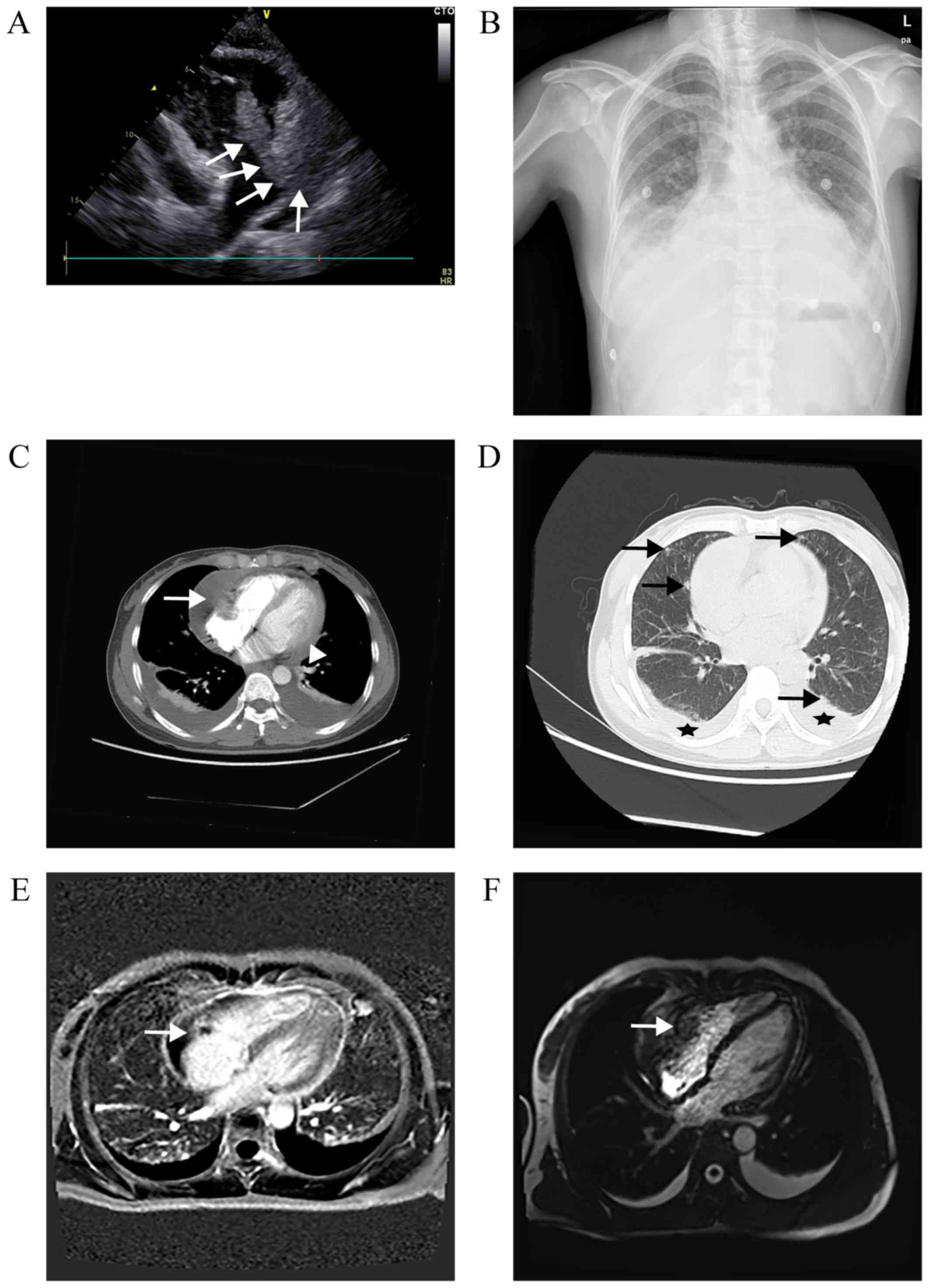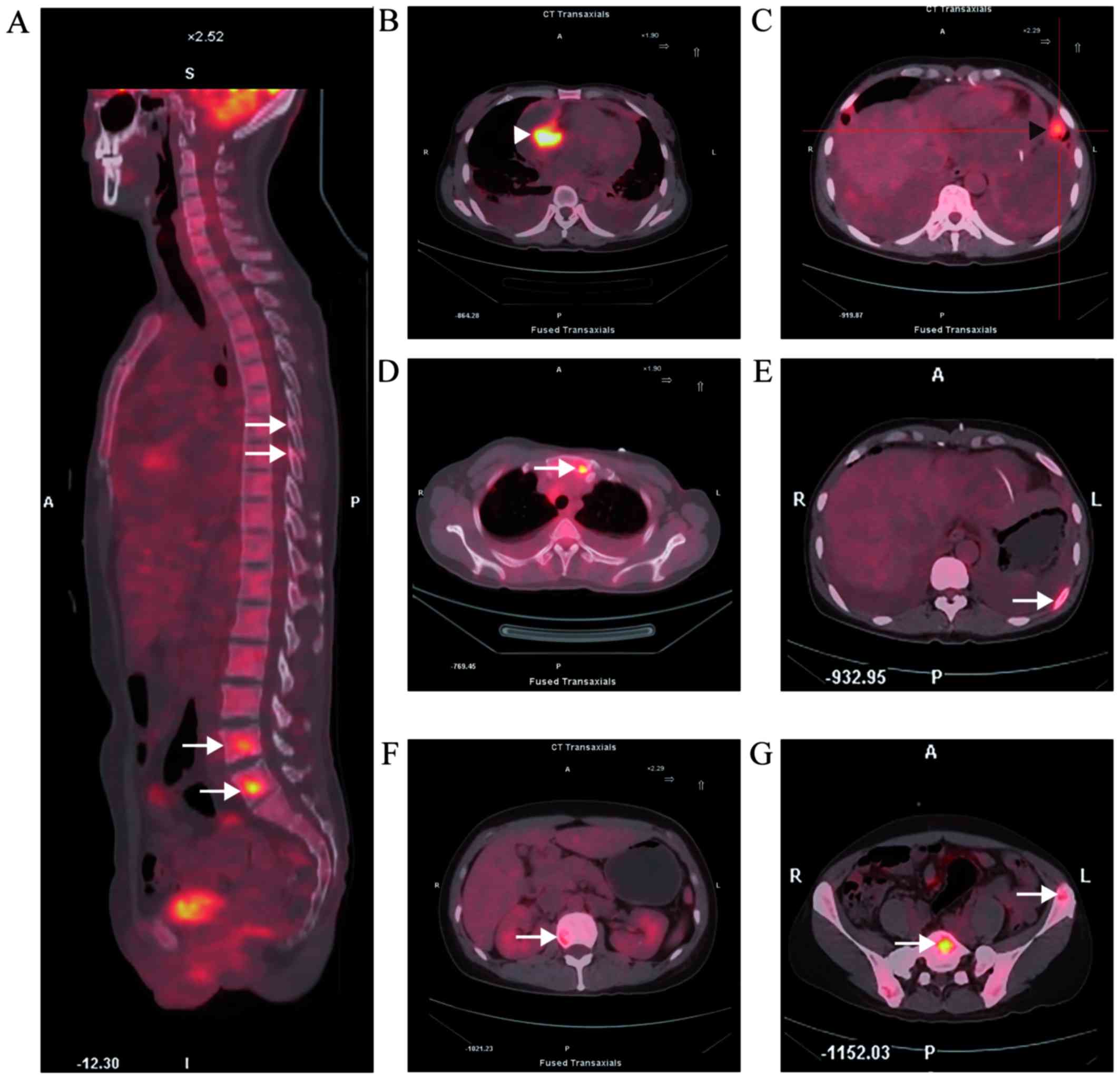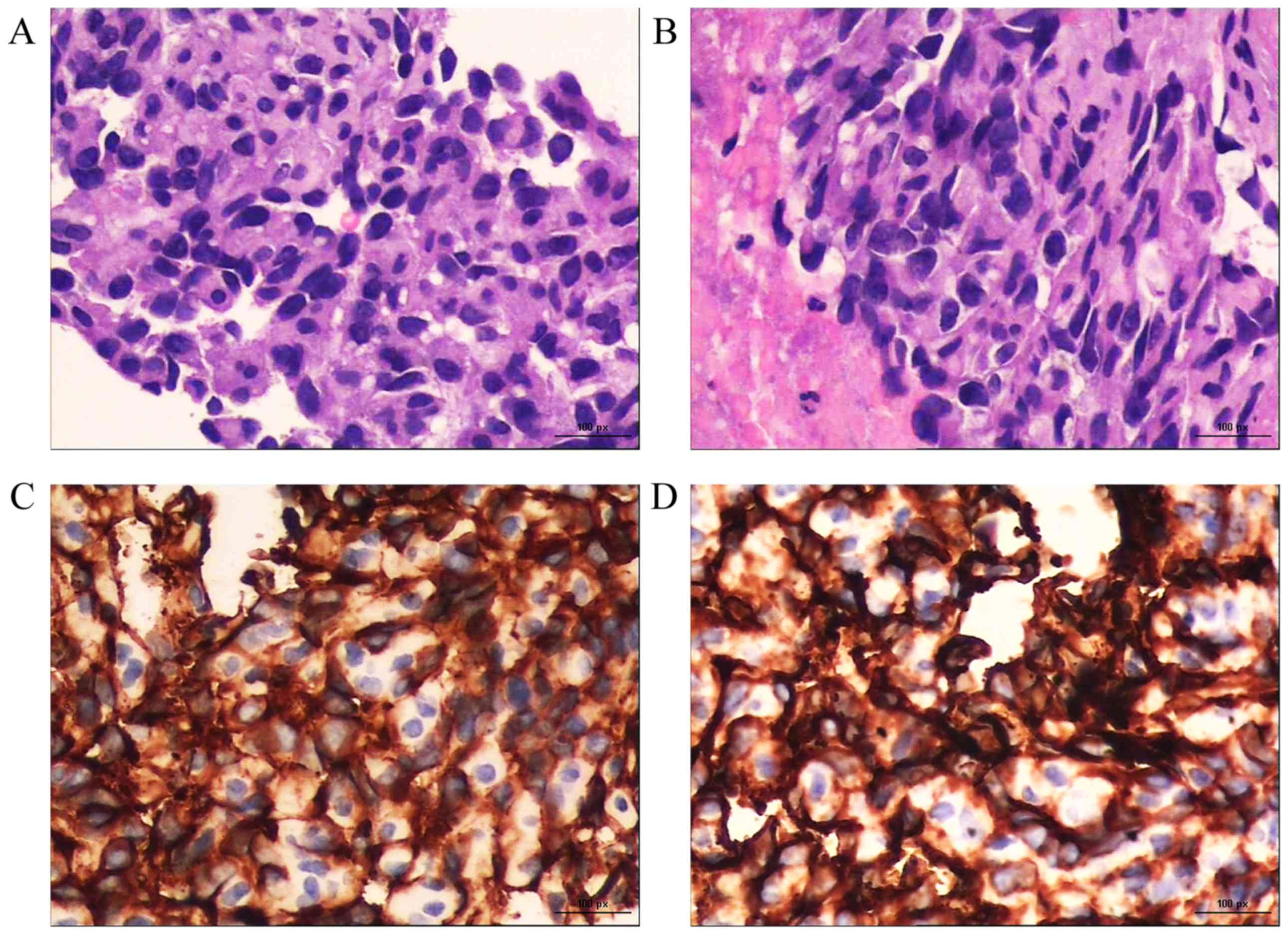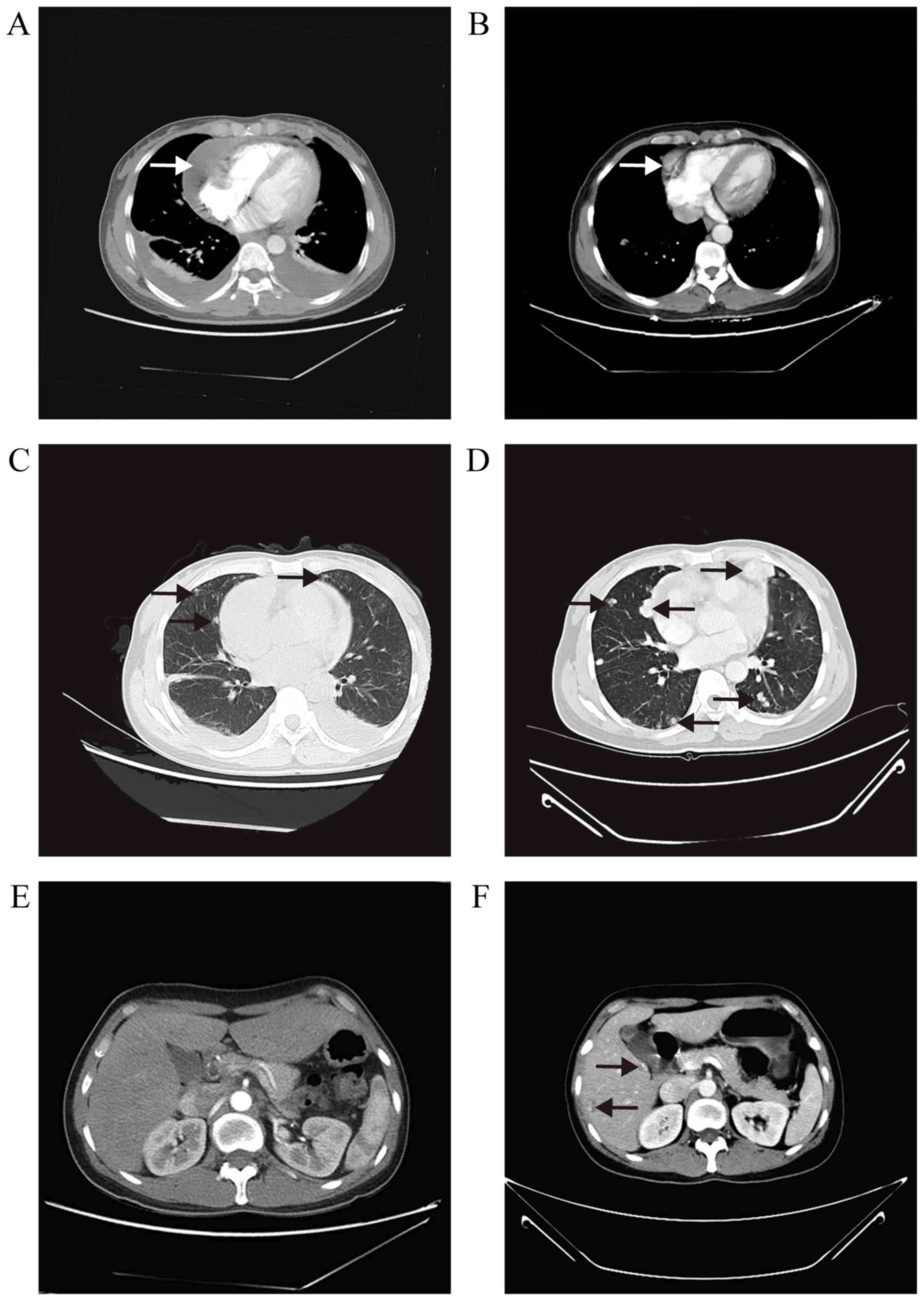Comprehensive treatment of unresectable cardiac angiosarcoma: A case report and review of literature
- Authors:
- Published online on: August 24, 2017 https://doi.org/10.3892/mco.2017.1390
- Pages: 859-863
Abstract
Introduction
Primary cardiac neoplasms are rare, with an incidence of ~0.2%. Primary cardiac angiosarcoma (PCA) comprises 2% of all primary cardiac neoplasms (including benign tumors) and is the most common primary malignant cardiac tumor (1,2). PCA typically presents between the third and fifth decades of life, most often arising in the right atrium (RA) and infiltrating the pericardium, which may cause right-sided heart failure or tamponade, usually with superimposed systemic signs, such as fever, night sweats, chills, fatigue and weight loss. Pericardiocentesis yields bloody fluid that often does not contain malignant cells, even when the tumor cells have invaded the pericardium (3). Diagnostic assessment includes tissue biopsy followed by histological confirmation, transthoracic echocardiography (TTE) to determine the tumor dimensions, pericardial status and cardiac function, computed tomography (CT) imaging to exclude metastatic disease, magnetic resonance imaging (MRI) to depict the extracardiac extent of the disease and delineate the extent of the primary lesion; positron emission tomography (PET) imaging may also be useful for detecting metastases when radical surgery is planned (2,4). However, even radical surgery often yields unsatisfactory results, as >90% of the patients succumb to the disease within 1 year (5). Comprehensive treatment includes neoadjuvant or adjuvant chemotherapy, radiotherapy or targeted therapy with complete surgical resection; even orthotopic heart transplantation may prove beneficial for the patients (6). We herein report a case of unresectable PCA originating in the RA. The patient received first-line chemotherapy with weekly paclitaxel, and second-line therapy with vinorelbine and bevacizumab when the disease progressed. The relevant literature was also reviewed, to compare and summarize the treatment of unresectable locally advanced or metastatic PCA.
Case report
In June 2015, a healthy 41-year-old Chinese woman complained of a 2-month progressive shortness of breath and chest discomfort for no apparent reason, which was relieved by rest. There was no precordialgia, no radiating back pain, no headache or dizziness, and no edema in the lower extremities. The previous medical history revealed that the patient had presented with unexplained pericardial effusion and underwent pericardiocentesis; however, analysis of the pericardial fluid failed to determine the etiology. On auscultation, there were no heart murmurs or lung rales, with the exception of a pericadial rub. The results of the laboratory tests were as follows: Carbohydrate antigen (CA)125 435.70 U/ml (normal, <35.00 U/ml), CA199 12.70 U/ml (normal, <35.00 U/ml), carcinoembryonic antigen (CEA)1.69 ng/ml (normal, <5.00 ng/ml) and neuron-specific enolase 32.51 ng/ml (normal, <17.00 ng/ml). TTE revealed a large mass (6.7×3.7 cm), originating from the free wall of the RA, of which the lower part entered the right ventricle (RV) during diastole (Fig. 1A), accompanied by a massive pericardial effusion. Chest X-ray revealed expansion of the heart shadow (cardiothoracic ratio, 70%) and bilateral pleural effusion (blunting of the bilateral costophrenic angle; Fig. 1B). A CT scan confirmed the presence of a heterogeneous irregularly shaped mass infiltrating the RA, and also detected bilateral pulmonary nodules (Fig. 1C and D). On MRI, the mass exhibited heterogeneous signal intensity enhancement on T1-weighted images, and flow void on T2-weighted images (Fig. 1E and F). The 18F-fluorodeoxyglucose uptake in the tumor reached a standardized uptake value of 13.6 (Fig. 2B). PET-CT also revealed tumor metastasis to multiple organs, including the lungs and bones (Fig. 2A and C-G). CT-guided percutaneous biopsy of a left ilium metastasis revealed poorly differentiated spindle-shaped tumor cells with slit-like or irregular vascular channels containing red blood cells (RBCs; hematoxylin and eosin staining; magnification, ×400). Immunohistochemically, the tumor cells were positive for CD31 and CD34 (magnification, ×400; Fig. 3). Taken together, these findings confirmed the diagnosis of metastatic PCA (T2N1M1).
Although the patient's performance status score was 1 on the Eastern Cooperative Oncology Group scale, the tumor had metastasized to other internal organs and total excision of the cardiac tumor was anatomically impossible. Therefore, 90 mg/m2 paclitaxel was administered intravenously on days 1, 8 and 15 of a 28-day cycle. Prior to the administration of paclitaxel, the patient received intravenous premedications, including dexamethasone 5 mg, cimetidine 400 mg and phenergan 25 mg. Standard antiemetics (mainly palonosetron 0.25 mg) were prescribed by the treating physician when clinically indicated. Cycles could not be initiated unless the granulocyte count was >1500/μl and the platelets were >100,000/μl. The treatment was well-tolerated by the patient, except for grade II neutropenia (white blood cells 2.41×109/l, neutrophils 1.06×109/l) and prophylactic granulocyte colony-stimulating factor was administered at 150 μg. In December 2015, TTE revealed a shrinkage in the cardiac tumor size (1.5×1.1 cm) and absorption of the pericardial effusion. A CT scan, however, revealed that the volume of the pulmonary nodules had increased and identified new foci in the liver (Fig. 4). On laboratory tests the CA125 level was 19.00 U/ml, the CA199 level was 37.60 U/ml and the CEA level was 8.13 ng/ml. Therefore, vinorelbine was selected as second-line treatment, with 25 mg/m2 vinorelbine administered intravenously on days 1 and 8 of a 21-day cycle. In December 24, bevacizumab was added to the therapy scheme (vinorelbine 25 mg/m2 on days 1 and 8 of a 21-day cycle following administration of bevacizumab 10 mg/kg on day 1). The patient complained of abdominal pain; thus, Oxycontin was administered at 30 mg/12 h to control the symptom. On January 8, 2016, the patient displayed anemia and respiratory failure (hemoglobin 56 g/l, RBC count 2.16×1012, PaO2 9.18 kPa, PaCO2 4.63 kPa, SpO2 91.5%, actual base excess 18.9 mmol/l, standard base excess 19.4 mmol/l, D-dimer 40.00 mg/l, and fibrin degradation products 128.1 mg/l) and was unable to tolerate the chemotherapy; thus, a blood transfusion was performed, with oxygen inhalation and diprophylline injection. The patient succumbed to respiratory failure 7 months after diagnosis.
Discussion
Due to the rapid local relapse and high incidence of systemic metastasis, PCA has a dismal prognosis, with a mean life expectancy of only a few months. The literature focusing on the treatment of unresectable PCA was reviewed. Although the relevant studies were scarce, several case reports and results from phase II trials expanded our knowledge of this rare disease. A summary of most common locations, treatment modalities and outcome is presented in Table I. The cases included in the Table I were almost inoperable, which was undoubtedly among the key factors determining the patients' prognosis. Although there are currently no established guidelines for the treatment of angiosarcoma, no further subgroups have been identified by which adjuvant therapy could be recommended; as previously reported, chemotherapy, radiotherapy and targeted therapy are the most common choices for the treatment of unresectable PCA. In the present case, addition of radiotherapy to the second-line treatment was initially attempted, as several cases of PCA exhibited high sensitivity to radiotherapy (14–16); however, due to the patient's poor physical condition, radiotherapy had to be abandoned. Weekly paclitaxel has been reported to be effective in the treatment of unresectable angiosarcomas (including PCA), with a median progression-free survival (PFS) of 4 months and a median overall survival of 8 months (17). Vinorelbine has demonstrated antitumor activity in angiosarcoma, as monotherapy or combined with gemcitabine (18,19). Bevacizumab is a recombinant humanized monoclonal IgG1 antibody that blocks the activity of vascular endothelial growth factor (VEGF)-A. A phase II trial concluded that bevacizumab is an effective and well-tolerated single-agent treatment for metastatic or locally advanced angiosarcoma (20). Several case reports demonstrated that combination therapy with bevacizumab and chemotherapy or radiotherapy may improve quality of life and survival in patients with metastatic angiosarcoma (21–25). In addition, another VEGF inhibitor, pazopanib, may prolong the PFS of metastatic non-adipocytic soft-tissue sarcoma after previous chemotherapy (26), particularly when used as maintenance therapy for PCA (16).
Table I.Cases of unresectable cardiac angiosarcoma reported in the English literature identified through a PubMed search. |
In conclusion, unresectable cardiac angiosarcomas are rare but lethal. In such cases, a multimodality approach including image-guided radiotherapy and targeted therapy may be considered, as the overall prognosis of these patients is poor. Further clinical trials focusing on the treatment of unresectable PCA are warranted.
Acknowledgements
The present study was supported by the National Science Foundation of China (grant nos. 81672327, 81372645, 81502013 and 81602411) and the Program of Shanghai Academic/Technology Research Leader (grant no. 17XD1402600), the Fong Shu Fook Tong Foundation and National Key Clinical Discipline (Oncology), the Shanghai Municipal Education Commission-Gaofeng Clinical Medicine Grant Support (grant no. 20161410), the Program for Outstanding Medical Academic Leader and Shanghai Municipal Commission of Health and Family Planning (grant no. 20154Y496).
References
|
Kurian KC, Weisshaar D, Parekh H, Berry GJ and Reitz B: Primary cardiac angiosarcoma: Case report and review of the literature. Cardiovasc Pathol. 15:110–112. 2006. View Article : Google Scholar : PubMed/NCBI | |
|
Kupsky DF, Newman DB, Kumar G, Maleszewski JJ, Edwards WD and Klarich KW: Echocardiographic features of cardiac angiosarcomas: The mayo clinic experience (1976–2013). Echocardiography. 33:186–192. 2016. View Article : Google Scholar : PubMed/NCBI | |
|
Araoz PA, Eklund HE, Welch TJ and Breen JF: CT and MR imaging of primary cardiac malignancies. Radiographics. 19:1421–1434. 1999. View Article : Google Scholar : PubMed/NCBI | |
|
Young RJ, Brown NJ, Reed MW, Hughes D and Woll PJ: Angiosarcoma. Lancet Oncol. 11:983–991. 2010. View Article : Google Scholar : PubMed/NCBI | |
|
Prabu Ram MP, Thulkar S, Ray R and Bakhshi S: Primary cardiac angiosarcoma with good response to Paclitaxel. J Thorac Oncol. 6:1778–1779. 2011. View Article : Google Scholar : PubMed/NCBI | |
|
Pigott C, Welker M, Khosla P and Higgins RS: Improved outcome with multimodality therapy in primary cardiac angiosarcoma. Nat Clin Pract Oncol. 5:112–115. 2008. View Article : Google Scholar : PubMed/NCBI | |
|
Suderman D, Cooke A, Wong R and Klein J: Treatment of cardiac angiosarcoma with radiation and docetaxel: A case report with partial response and prolonged stable disease. J Thorac Oncol. 6:834–835. 2011. View Article : Google Scholar : PubMed/NCBI | |
|
Kodali D and Seetharaman K: Primary cardiac angiosarcoma. Sarcoma. 2006:391302006. View Article : Google Scholar : PubMed/NCBI | |
|
Hata A, Katakami N, Fujita S, Kokubo M and Imai Y: Angiosarcoma arising from right atrium: Remarkable response to concurrent chemoradiotherapy with carboplatin and paclitaxel. J Thorac Oncol. 6:970–971. 2011. View Article : Google Scholar : PubMed/NCBI | |
|
Franceschini D, Scotti V, Simontacchi G, Meattini I, Paiar F, Greto D, Bonomo P, Franzese C, Di Cataldo V, Pallotta S and Biti G: Application of helical tomotherapy for the treatment of a right atrium angiosarcoma: A case report. Tumori. 99:e233–e236. 2013.PubMed/NCBI | |
|
Fehr M, Kuhn M, Mayer K, Padberg B, Ulmer U and Cathomas R: Metastatic angiosarcoma arising from the right atrium: Unusual presentation and excellent response to treatment in a young patient. J Thorac Oncol. 5:1301–1302. 2010. View Article : Google Scholar : PubMed/NCBI | |
|
Castilla E, Pascual I, Roncalés F, Aguirre E and Del Río A: Transient response of cardiac angiosarcoma to paclitaxel. Eur J Cancer Care (Engl). 19:699–700. 2010. View Article : Google Scholar : PubMed/NCBI | |
|
Batzios S, Michalopoulos A, Kaklamanis L, Stathopoulos J, Christopoulou M, Koutantos J and Stathopoulos GP: Angiosarcoma of the heart: Case report and review of the literature. Anticancer Res. 26:4837–4842. 2006.PubMed/NCBI | |
|
Aoka Y, Kamada T, Kawana M, Yamada Y, Nishikawa T, Kasanuki H and Tsujii H: Primary cardiac angiosarcoma treated with carbon-ion radiotherapy. Lancet Oncol. 5:636–638. 2004. View Article : Google Scholar : PubMed/NCBI | |
|
Elsayad K, Lehrich P, Yppaerilae-Wolters H, Dieckmann C, Kriz J, Haverkamp U and Eich HT: Primary cardiac angiosarcoma treated with positron emission tomography/magnetic resonance imaging-guided adaptive radiotherapy. Can J Cardiol. 32:829.e7–829.e10. 2016. View Article : Google Scholar | |
|
Elsayad K, Scobioala S, Kriz J, Haverkamp U and Eich HT: Advances in image-guided radiation therapy for primary cardiac angiosarcoma: The role of PET-CT and MRI. Oncol Res Treat. 39:290–294. 2016. View Article : Google Scholar : PubMed/NCBI | |
|
Penel N, Bui BN, Bay JO, Cupissol D, Ray-Coquard I, Piperno-Neumann S, Kerbrat P, Fournier C, Taieb S, Jimenez M, et al: Phase II trial of weekly paclitaxel for unresectable angiosarcoma: The ANGIOTAX study. J Clin Oncol. 26:5269–5274. 2008. View Article : Google Scholar : PubMed/NCBI | |
|
Anderson SE, Keohan ML, D'Adamo DR and Maki RG: A retrospective analysis of vinorelbine chemotherapy for patients with previously treated soft-tissue sarcomas. Sarcoma. 2006:159472006. View Article : Google Scholar : PubMed/NCBI | |
|
Dileo P, Morgan JA, Zahrieh D, Desai J, Salesi JM, Harmon DC, Quigley MT, Polson K, Demetri GD and George S: Gemcitabine and vinorelbine combination chemotherapy for patients with advanced soft tissue sarcomas: Results of a phase II trial. Cancer. 109:1863–1869. 2007. View Article : Google Scholar : PubMed/NCBI | |
|
Agulnik M, Yarber JL, Okuno SH, von Mehren M, Jovanovic BD, Brockstein BE, Evens AM and Benjamin RS: An open-label, multicenter, phase II study of bevacizumab for the treatment of angiosarcoma and epithelioid hemangioendotheliomas. Ann Oncol. 24:257–263. 2013. View Article : Google Scholar : PubMed/NCBI | |
|
Yang P, Zhu Q and Jiang F: Combination therapy for scalp angiosarcoma using bevacizumab and chemotherapy: A case report and review of literature. Chin J Cancer Res. 25:358–361. 2013.PubMed/NCBI | |
|
De Yao JT, Sun D, Powell AT and Rehmus EH: Scalp angiosarcoma remission with bevacizumab and radiotherapy without surgery: A case report and review of the literature. Sarcoma. 2011:1603692011. View Article : Google Scholar : PubMed/NCBI | |
|
Koontz BF, Miles EF, Rubio MA, Madden JF, Fisher SR, Scher RL and Brizel DM: Preoperative radiotherapy and bevacizumab for angiosarcoma of the head and neck: Two case studies. Head Neck. 30:262–266. 2008. View Article : Google Scholar : PubMed/NCBI | |
|
Jeng MR, Fuh B, Blatt J, Gupta A, Merrow AC, Hammill A and Adams D: Malignant transformation of infantile hemangioma to angiosarcoma: Response to chemotherapy with bevacizumab. Pediatr Blood Cancer. 61:2115–2117. 2014. View Article : Google Scholar : PubMed/NCBI | |
|
Nespereira-Jato MV, Peña-Panabad C, Quindós-Varela M and García-Silva J: Unresectable angiosarcoma treated with bevacizumab and paclitaxel. Actas Dermosifiliogr. 105:520–522. 2014. View Article : Google Scholar : PubMed/NCBI | |
|
van der Graaf WT, Blay JY, Chawla SP, Kim DW, Bui-Nguyen B, Casali PG, Schöffski P, Aglietta M, Staddon AP, Beppu Y, et al: Pazopanib for metastatic soft-tissue sarcoma (PALETTE): A randomised, double-blind, placebo-controlled phase 3 trial. Lancet. 379:1879–1886. 2012. View Article : Google Scholar : PubMed/NCBI |













